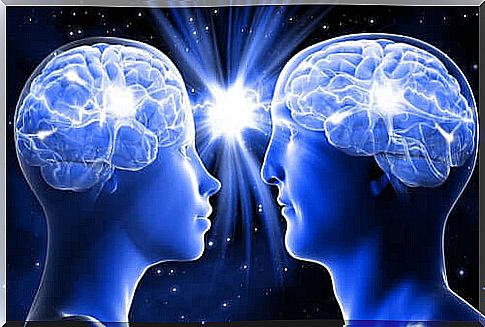How Eye Contact Prepares The Brain To Connect

We all know the power of eye contact with another human being. It’s something very special that helps us convey a lot of information and, in turn, tells us a lot about the other person. Furthermore, when we make eye contact with someone, we are sharing an affective and mental state.
Good friends just need a look to communicate something. To lose yourself in the eyes of your loved one is to enter their world. Eye contact activates our social brain, our intentions and our emotions.
Now, a new study using MRI images has revealed a lot of data about what eye contact activates in our brains in real time and beyond. The first fact is that when we make eye contact, we synchronize our blink with the other person’s. But there is so much more. Let’s see what happens.
The blink in eye contact
It appears that eye contact activates the social brain and synchronizes eye movements and blinks of two people looking each other in the eye. That is, there is a neural activation that reorganizes our response to other people.

Eye contact is one of the most outstanding automatic mimics. Also, it’s a way of telling the other that we’re paying attention to them. Promotes social interaction and facilitates effective communication. The blinking of the eyes expresses a cognitive charge that projects people’s internal state.
Until now, brain imaging studies were able to study the brain activity of only one person at a time. But Norihiro Sadato’s team from Japan’s National Institute of Physiological Sciences began working with a new technique known as hyperscanning.
The study
The results of this experiment show us what happens in the brain, in real time, when two people look each other in the eye for the first time. Hyperscanning made it possible to look at the brains of two people at the same time, on separate functional MRI machines, and have them communicate visually. In this study, Sadato’s team used 32 people, grouped in pairs and placed on two RMF machines at the same time.
The experiment could not be carried out with people looking at each other face to face because MRI requires individuals to be inside a machine and remain completely still.
Each scanner was also equipped with a video screen and camera. The participants didn’t know each other, so eye contact was completely new for all of them. Eye blinking was used as a marker of synchronization between participants.
The experiment measured the subjects’ brain activity in two different phases. At first, a blank screen was shown and then the image of the experiment partner (whom they didn’t know) was shown, first in real time and then with a delay of 20 seconds on the image. They were instructed to focus on what the other person was thinking, what their personality would be, or how they were feeling.
The results
First, significant differences were detected in terms of brain activation of real-time eye contact and that produced with seconds of delay.
During real time, participants were more sensitive to the other individual ‘s blink than to out-of-time images. There was also greater connectivity in the limbic mirror system and greater activation in the cerebellum.
The study showed that eye contact prepares the social brain to develop empathy and activates the same brain areas in both people at the same time. Activation of the cerebellum helps predict the sensory consequences of actions.

Eye Contact: Our Brain’s Incredible Power
The limbic system is associated with our ability to share and recognize emotions, which is essential for the emergence of empathy. There seems to be a strong mutual influence between the blinks of both people when eye contact occurs.
This means that eye contact prepares the social brain to share other people’s mental states and is the foundation for effective social communication. Finally, this study showed that our brains distinguish between real-time images and images recorded in an absolutely unconscious way, a fact that we believe is the most significant of all.









